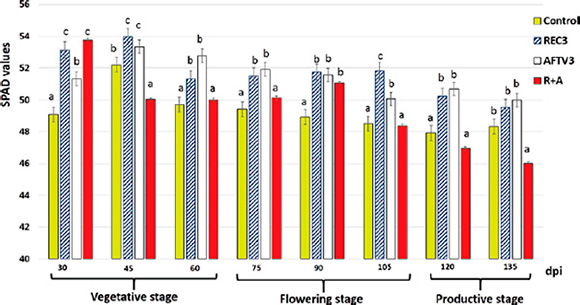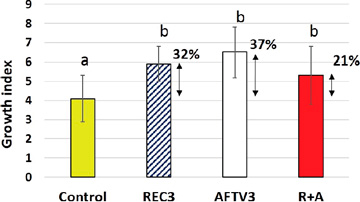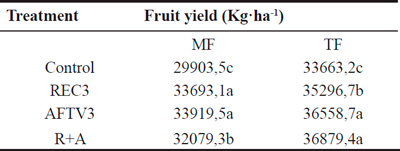Serviços Personalizados
Journal
Artigo
Indicadores
-
 Citado por SciELO
Citado por SciELO
Links relacionados
-
 Similares em
SciELO
Similares em
SciELO
Compartilhar
Revista agronómica del noroeste argentino
versão impressa ISSN 0080-2069versão On-line ISSN 2314-369X
Rev. agron. noroeste arg. vol.35 no.1 San Miguel de Tucumán jun. 2015
SHORT COMMUNICATION
Response of strawberry plants inoculated with Azospirillum and Burkholderia at field conditions
Respuesta de plantas de frutilla inoculadas con Azospirillum y Burkholderia en condiciones de campo
N.C. Lovaisa1,2; M.F. Guerrero Molina1,2,3; P.G.A. Delaporte Quintana1,2; S.M. Salazar1-4
1Facultad de Agronomía y Zootecnia, Universidad Nacional de Tucumán. E-mail: nadiaclov@hotmail.com
Avda. Kirchner 1900, (4000) San Miguel de Tucumán. Tucumán, Argentina.
2Consejo Nacional de Investigaciones Científicas y Técnicas (CONICET), Argentina.
3Instituto Superior de Investigaciones Biológicas (INSIBIO-UNT-CONICET),
Instituto de Química Biológica "Dr. Bernabé Bloj", Facultad de Bioquímica, Química y Farmacia, UNT.
Chacabuco 461, (4000) San Miguel de Tucumán. Tucumán, Argentina.
4INTA EEA Famaillá. Ruta Prov. 301 Km 32, (4132) Famaillá. Tucumán, Argentina.
Abstract
The use of synthetic fertilizers is a most common practice used to incorporate nutrients in agricultural soils; these are expensive leading to increases in the total crop-production costs. This traditional crop management may turn inefficient and polluting as part of the nutrients can be lost by lixiviation or become insoluble by cation exchange. Therefore, the aim of this study was to evaluate the agronomic response of strawberry plants (Fragaria ananassa Duch.) inoculated with two native PGPB as a biotechnological alternative to the plant nutrition. The experiment was carried out under field conditions during 2014, using strawberry plants cv. 'Fortuna Florida' inoculated with the local strains Azospirillum brasilense REC3 and Burkholderia vietnamensis AFTV3, applied individually and combined. Results showed greater growth index (30%) and relative chlorophyll content in leaves (10%) in inoculated plants compared to non-inoculated controls, and also increased commercial fruit yield in plants inoculated with A. brasilense REC3 (12.6%), B. vietnamensis AFTV3 (13.4%) and both (7.2%) in comparison with uninoculated controls.
Keywords: Fragaria ananassa; Azospirillum; Burkholderia; PGPB; Inoculation
Resumen
La utilización de fertilizantes sintéticos es la práctica más empleada para la provisión de nutrientes en los suelos agrícolas, a pesar de ser costosos, y de encarecer el costo de producción. Parte de los mismos pueden perderse por lixiviación o tornarse insolubles por intercambio de cationes, haciendo que el proceso tradicional de cultivo sea poco eficiente, además de contaminar el medio ambiente. Es por ello que el objetivo de este trabajo fue estudiar la respuesta agronómica en plantas de frutilla (Fragaria ananassa Duch.) empleando 2 cepas PGPB nativas como una alternativa biotecnológica en la nutrición vegetal. El ensayo se realizó en condiciones de campo en 2014. Se utilizaron plantas de frutilla cultivar 'Fortuna Florida' que fueron inoculadas con las cepas locales Azospirillum brasilense REC3 y Burkholderia vietnamensis AFTV3, aplicadas en forma individual y combinadas. De manera general, se observó que las plantas inoculadas presentaron un mayor índice de crecimiento (30%) y contenido relativo de clorofila en sus hojas (10%), respecto al control no inoculado. También incrementaron el rendimiento de frutos comerciales las plantas inoculadas con A. brasilense REC3 (12,6%), B. vietnamensis AFTV3 (13,4%) y la mezcla de ambas (7,2%) respecto a los controles sin inocular.
Recibido 06/03/15; Aceptado 29/05/15.
Los autores declaran no tener conflicto de intereses.
Palabras clave: Fragaria ananassa; Azospirillum; Burkholderia; PGPB; Inoculación
The incorporation of nitrogen into agricultural soils can be done through the decomposition of organic matter, electric discharge during rainfalls, application of synthetic chemical fertilizers, and by the process of biological nitrogen fixation (BNF). Among these possibilities, the application of synthetic fertilizers is the most widely used practice in spite of being expensive, which increases the total crop-production cost. Even more, this traditional crop management may be inefficient and polluting as part of the chemicals applied are lost by lixiviation or become insoluble by cation exchange (Pardo et al., 2009).
Strawberry is a commercial intensive crop that requires the application of fertilizers during different phenological stages. Nitrogen-fertilizer doses applied are not fixed; they may vary according to the strawberry cultivar demands and nutritional soil conditions from 150 to 200 kg·ha-1 (Agüero and Kirschbaum, 2013).
It is well known that plant growth-promoting bacteria (PGPB) are capable of effectively colonize plant roots and promote plant growth throughout many direct and indirect mechanisms, including nutrients solubilization and uptake, phytohormone synthesis and biocontrol of pathogens (Bashan and de-Bashan, 2005; Lucy et al., 2004). Thus, the use of PGPB, such as Azospirillum and Burkholderia in strawberry cropping would be a biotechnological alternative to partially or totally substitute the use of nitrogen fertilizers and avoid environmental pollution.
It has been reported that Burkholderia genus is capable of increasing crop yields in different plant species, e.g. rice, sugar cane and maize (Van et al., 2000; Hernández-Rodríguez et al., 2010), but there is not available information on its use in strawberry crop. In a previous work we have isolated and characterized several strains of this genus from strawberry roots, being the strain B. vietnamensis AFTV3 the one showing remarkable PGPB features such as N2-fixation, indoles and siderophores production, and phosphate solubilization (Lovaisa et al., 2011).
The genus Azospirillum has also been proven to have positive effects on growth and yields of several crops, including strawberry (Pedraza et al., 2010; Saikia et al., 2012). The strain A. brasilense REC3 outstands among other isolates from the province of Tucumán (Argentina) because of its PGPB traits and also because it was able to promote growth, enhance mineral nutrition, and increase fruit yield of different cultivars of strawberry (Pedraza et al., 2007; 2010; Salazar et al., 2012; Guerrero-Molina et al., 2014).
Therefore, the aim of this study was to evaluate the agronomic response of strawberry plants (Fragaria ananassa Duch.) inoculated with two native PGPB as a biotechnological alternative to the plant nutrition.
To accomplish this objective, an experiment using strawberry plants was set at field conditions. For this, plants of strawberry (Fragaria ananassa, Duch) cv. 'Fortuna Florida' (short day cultivar), were used. They were purchased from commercial nurseries of El Maitén, Chubut, Argentina. The experiments were conducted on a silt loam soil (pH = 5.7; EC = 0.6 mS·cm-1), during one annual production cycle (2014) at INTA's Estación Experimental Agropecuaria Famaillá (27° 03 S, 65° 25 W, 363 m elevation) in Tucumán, Argentina. Cropping beds consisted of raised beds 1.25 m apart, 0.40 m high, 0.50 m wide, covered with black polyethylene mulch, with two rows of plants (50,000 plants·ha-1). A rate of 120 kg·ha-1 of 15-15-15 (N, P, K) fertilizer was applied as pre-planting fertilizer. The experimental design was a completely randomized block, with six replications of 40 plants each. Fruit were harvested from May through October, two or three times a week, according to fruit maturity.
The bacterial strains used in this study were Azospirillum brasilense REC3 and Burkholderia vietnamensis AFTV3, both isolated from roots of strawberry cultivated in Tucumán.
Plant roots were inoculated once by immersion into pure bacterial suspension (106 CFU·ml-1) for 30 min before implantation. NFb and LGI liquid media (Baldani et al., 2014) were used to grow A. brasilense REC3 and B. vientnamensis AFTV3, respectively.
Along the whole production period, the relative chlorophyll content was periodically measured every 2 weeks from 30 days of implantation by using a Minolta SPAD-502 chlorophyll-meter. These results were expressed as SPAD values.
Fruits were graded into marketable (>10 g per fruit) and non-marketable (<10 g, either with disease symptoms or deformed). The threshold value for marketable fruit was 10 g since fruits over this weight are sold either for fresh consumption (larger fruit sizes) or processing (smaller fruit sizes). Variables measured were total fruit-yield (kg·ha-1) and marketable fruit-yield (kg·ha-1). One-way ANOVA analysis and Tukey´s multiple comparison tests (p ≤0.05) were done with Statistix Analytical Software 1996 for Windows®.
By the end of the cropping season, roots and shoot were oven dried at 65° C for 72 h (constant weight) and dry weight of each tissue was recorded. The growth index (GI) was calculated with the dry weight data according to the formula:
GI=[(final biomass-initial biomass)/initial biomass]
As result, the relative chlorophyll content values decreased from vegetative to productive stages. Also a positive impact was observed on strawberry chlorophyll content on leaves of inoculated plants in comparison to uninoculated controls (Figure 1).
Figure 1. SPAD relative values (mean ± standard error) of plants cv. 'Fortuna Florida' inoculated with REC3, AFTV3 and REC3 + AFTV3 (R+A) measured from 30 dpi (days post inoculation). Bars with the same letter are not significantly different (p ≤ 0.05).
The growth index of strawberry was significantly increased by the inoculation with REC3, AFTV3 and the combination of both (p ≤ 0.05). The highest values were observed in the treatments inoculated with AFTV3 (37%) and REC3 (32%), compared with control non-inoculated (Figure 2).
Figure 2. Growth index (mean ± standard error) of plants inoculated with REC3, AFTV3 and REC3 + AFTV3 (R+A). Bars with the same letter are not significantly different (p ≤ 0.05). Arrows indicate the % increment compared to the control.
The marketable and total fruit yield of strawberry inoculated with the PGPB is shown in Table 1.
Table 1. Marketable fruit yield of strawberry plants (MF) and total fruit yield of strawberry plants (TF) inoculated with REC3, AFTV3, and R+A,in Famaillá, Tucumán (Argentina), during 2014. Mean values within columns followed by the same letter are not significantly different (p ≤ 0.05).
After these results, we have observed that single strain inoculation with A. brasilense REC3 and B. vietnamensis AFTV3, as well as combined inoculation with bacteria strains, had a positive impact on relative chlorophyll values in plants var. Fortuna Florida. This can be interpreted as a greater N content on inoculated strawberry leaves, and this is important since plants were N-fertilized just once before crop-implantation. Hence, PGPB could have played an important role in strawberry plant nutrition through some of their mechanisms (e.g., indole production that may allow a better root development to absorb nutrients from soil; or the biological nitrogen-fixing process).
Also, PGPB- inoculation increased strawberry fruit yield, mainly of marketable type. This was observed in values between 7% and 13% higher than non-inoculated plants. Besides, this represents about 2,000 kg and 4,000 kg of fruit per hectare. Considering that a base fertilization was applied in every treatment when the crop was implanted, we can infer that the PGPB used conferred to the plants some differential advantages in their nutrition. Probably, this enables them to support a better fruit yield.
It is known that the application of A. brasilense on wheat caused increases in grain yields (Díaz-Zorita and Grove, 2006), and in corn plants increased their biomass and yield by 27% (Hungria et al, 2010). Regarding strawberry crop, it was reported the use of different beneficial microorganisms, such as Pseudomonas, Bacillus, and Azospirillum, indicating that they were able of increasing plant biomass and fruit yield (Esitken et al., 2010; Erturk et al., 2012; Salazar et al., 2012). Also, it was reported the capacity of A. brasilense as a biocontrol agent against anthracnose, a fungal disease of strawberry(Tortora et al., 2011).
Several species of Burkholderia have been reported by their beneficial effects such as increasing biomass in sugar cane (de Oliveira et al., 2006), and grain yield in maize and rice (Hernández-Rodríguez et al., 2010; Estrada et al., 2013). However, there is not information on its use in strawberry crop; therefore, this is the first report of B. vietnamensis applied to this crop at field conditions.
Considering that A. brasilense REC3 and B. vietnamensis AFTV3 promoted strawberry growth and increased strawberry fruit yield at field conditions, these PGPB are promising as a biotechnological alternative for strawberry plant nutrition.
Acknowledgements
This study is part of joint projects between INTA-Famaillá and Facultad de Agronomía y Zootecnia. This work was supported by Proyecto de Investigación de la Universidad Nacional de Tucumán (PIUNT) Program A526, and Instituto Nacional de Tecnología Agropecuaria (INTA) Programs PNHFA 1106073, Prets TUSGO-1231101 and 1231102.
References
1. Agüero J.J., Kirschbaum D.S. (2013). Approaches to nutrient use efficiency of different strawberry genotypes. International Journal of Fruit Science 13: 139-148. [ Links ]
2. Baldani J.I, Reis V.M., Videira S.S., Boddey L.H., Baldani V.LD. (2014). The art of isolating nitrogen-fixing bacteria from non-leguminous plants using N-free semi-solid media: a practical guide for microbiologists. Plant and Soil 384:413–431.
3. Bashan Y., de-Bashan L.E. (2005). Plant growth-promoting. In: Encyclopedia of soils in the environment. Hillel D (editor-in-chief). Elsevier, Oxford, p. 2200. [ Links ]
4. de Oliveira A.L.M., de Canuto E.L., Urquiaga S., Reis V.M., Baldani, J.I. (2006). Yield of micropropagated sugarcane varieties in different soil types following inoculation with diazotrophic bacteria. Plant and Soil 284: 23-32. [ Links ]
5. Díaz-Zorita M., Grove J. (2006). Wheat grain response to nitrogen fertilization and field inoculation with a liquid formulation of Azospirillum brasilense. ASA-CSSA-SSSA Abstracts of International Annual Meetings, Indianapolis, USA. [ Links ]
6. Estrada G.A., Baldani V.L.D., de Oliveira D.M., Urquiaga S., Baldani, J.I. (2013). Selection of phosphate-solubilizing diazotrophic Herbaspirillum and Burkholderia strains and their effect on rice crop yield and nutrient uptake. Plant and Soil 369:115-129. [ Links ]
7. Hernández-Rodríguez A., Heydrich-Pérez M., Diallo B., El Jaziri M., Vandeputte O.M. (2010). Cell-free culture medium of Burkholderia cepacia improves seed germination and seedling growth in maize (Zea mays) and rice (Oryza sativa). Plant Growth Regulation 60:191-197. [ Links ]
8. Hungria M., Campo R.J., Souza E.M., Pedrosa, F.O. (2010). Inoculation with selected strains of Azospirillum brasilense and A. lipoferum improves yields of maize and wheat in Brazil. Plant and Soil 331: 413-425. [ Links ]
9. Guerrero-Molina M.F., Lovaisa N.C., Salazar S.M., Díaz-Ricci J.C., Pedraza R.O. (2014). Elemental composition of strawberry plants inoculated with the plant growth-promoting bacterium Azospirillum brasilense REC3, assessed with scanning electron microscopy and energy dispersive X-ray analysis. Plant Biology 16: 726-731. [ Links ]
10. Lovaisa N.C., Silva E., Salazar S.M., Teixeira K.R.S., Pedraza R.O. (2011). Características promotoras del crecimiento vegetal en bacterias asociadas al suelo rizosférico y superficie radicular de plantas de frutilla (Fragaria ananassa Duch.). Avances en la producción vegetal y animal del NOA 2009-2011: 66-72. [ Links ]
11. Lucy M., Reed E., Glick B.R. (2004). Applications of free living plant growth-promoting rhizobacteria. Antonie van Leeuwenhoek 86: 1–25.
12. Pardo G., Cavero J., Aibar J., Zaragoza C. (2009). Nutrient evolution in soil and cereal yield under different fertilization type in dryland. Nutrient Cycling in Agroecosystems 84: 267-279. [ Links ]
13. Pedraza R.O., Motok J., Tortora M.L., Salazar S.M., Díaz-Ricci J.C. (2007). Natural occurrence of Azospirillum brasilense in strawberry plants. Plant and Soil 295: 169-178. [ Links ]
14. Pedraza R.O., Motok J., Salazar S.M., Ragout A.L., Mentel M.I., Tortora M.L., Guerrero-Molina M.F., Winik B.C., Díaz-Ricci J.C. (2010). Growth-promotion of strawberry plants inoculated with Azospirillum brasilense. World Journal of Microbiology and Biotechnology 26: 265-272. [ Links ]
15. Saikia S.P., Bora D., Goswami A., Mudoi K.D., Gogoi A. (2012). A review on the role of Azospirillum in the yield improvement of non leguminous crops. African Journal of Microbiology Research 6: 1085-1102. [ Links ]
16. Salazar S.M., Lovaisa N.C., Guerrero Molina M.F., Ragout A.L., Kirschbaum D.S., Pedraza, R.O. (2012). Fruit yield of strawberry plants inoculated with Azospirillum brasilense RLC1 and REC3 under field conditions. Revista Agronómica del Noroeste Argentino 32: 63-66. [ Links ]
17. Tortora M.L., Díaz-Ricci J.C., Pedraza R.O. (2011). Azospirillum brasilense siderophores with antifungal activity against Colletotrichum acutatum. Archives of Microbiology 193: 275-280. [ Links ]
18. Van V.T., Berge O., Ke S.N., Balandreau J., Heulin T. (2000). Repeated beneficial effects of rice inoculation with a strain of Burkholderia vietnamiensis on early and late yield components in low fertility sulphate acid soils of Vietnam. Plant and Soil 218: 273-284. [ Links ]

















